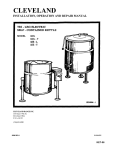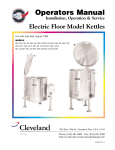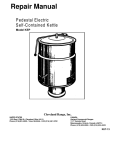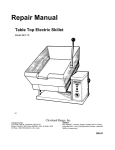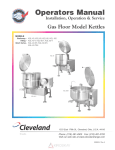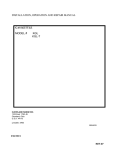Download Cleveland KDP Repair manual
Transcript
CLEVELAND INSTALLATION, OPERATION AND REPAIR MANUAL DIRECT STEAM KETTLES MODEL KDL - T KDL KDP CLEVELAND RANGE INC. 1333 East 179th St. Cleveland, Ohio U.S.A- 44110 (216)481-4900 9209 REV:1 233-01CC KET-09 INSTALLATION. OPERATION -AND MAINTENANCE INSTRUCTIONS FOR DIRECT STEAM KETTLES TILTING, STATIONARY, AND PEDESTAL MODELS KDL-25-T KDL-25 KDP-25 KDL-30-T KDL-30 KDP-30 KDL-40-T KDL-40 KDP-40 KDL-60-T KDL-60 KDP-60 PRODUCT INFORMATION MODEL STYLE ____________________ MODEL NO. _____________ SERIAL NO. ___________ INSTALLATION DATE______ INSTALLER ___________ RETAIN THIS MANUAL FOR YOUR REFERENCE 9203 REV:0 1 233-01TE 4. INSTALLATION INSTRUCTIONS FOR Fill out all carrier claims forms and have the examining carrier sign and date each form. DIRECT STEAM KETTLES INSTALLATION The first installation step is to refer to the specification sheet for clearance requirements, in order to determine the location of the kettle. Next, carefully cut open the shipping carton for easy removal of the kettle. WARNING:Installauon of kettle must be accomplished by qualified installation personnel, working to all applicable local and national codes. Improper installation of product could cause injury or damage. This equipment is built to comply with applicable standards for manufacturers. Included among those approval agencies are: UL, NSF, ASME/Ntl.Bd., CSA, ETL, and others. Many local codes exist, and it is the responsibility of the owner and installer to comply with these codes. KDL SERIES (Tri-Leg Models) Position the kettle in its permanent location, and level the kettle by turning the adjustable flanged feet. Once positioned and levelled, permanently secure the kettle's flanged feet to the floor using 5/16" lag bolts and floor anchors (to be supplied by the installer). There are three bolts required to secure each of the flanged feet. INSPECTION Before unpacking visually inspect the unit for evidence of damage during shipping. If damage is noticed, do not unpack the unit, follow shipping damage instructions. KDP SERIES (Pedestal Models) SHIPPING DAMAGE INSTRUCTIONS 1. Position the kettle in its permanent location, and mark the floor around the circumference of the base collar or the base plate. Locate the centre of this circle and mark the floor at this centre point. This is the point at which the kettle's base plate will be secured to the floor. 2- Lay kettle on its side (on a cushioned surface to prevent scratching), and slide the base collar up the pedestal, exposing the plate for removal. 3. Remove the four cap screws securing the base plate and slide it off the kettle. If shipping damage to the unit is discovered or suspected, observe the following guidelines in preparing a shipping damage claim. 1. 2. 3. Write down a description of the damage or the reason for suspecting damage as soon as it is discovered. This will help in filling out the claim forms later. As soon as damage is discovered or suspected, notify the carrier that delivered the shipment. Arrange for the carrier's representative to examine damage. 2 4. 5. Prepare the floor location, for mounting the kettle, by installing a 3/4"(19mm) stud, cast into the floor, at the base plate's centre point. Note: a 3/4"(19mm) lag bolt and floor anchor may be substituted for a cast-in stud. The anchor is installed in the floor, and the lag bolt is threaded down through the base plate, into the anchor, after completion of step 6. Thread the four 3/8"(10mm) levelling bolts into plate from the top, and insert the plate over stud. 6. Adjust bolts until the plate is level. 7. Install a nut on the 3/4" (19mm) bolt (or insert a lag bolt if the alternate fastener method is used) and secure base plate to the floor. 8. Check for level "set" of the kettle by placing the kettle on the base plate with the screw holes aligned and applying a carpenter's level at the kettle rim. If the kettle is level, it may be fastened in place with the four cap screws. If the kettle is not level, the kettle must be removed from the base, the plate loosened, and the levelling bolts re-adjusted until a level installation is attained. 9. Slide the base collar down to the floor, and draw a line around the circumference of the pedestal at the top of the collar, using the top of the collar as a guide. Slide the collar back up the pedestal. 10. Apply a bead of silicone sealer to the circumference of the pedestal, at the line, and also to the bottom rim of the collar. 3 Slide the collar down the pedestal and press it tightly to the floor. The silicone sealer will create a seal where the collar meets the pedestal, and where the collar meets the floor. SERVICE CONNECTIONS Install service connections as required. Locations and other data are shown on the specification sheet. STEAM All steam plumbing to and from the kettle and steam boiler should be thoroughly cleaned and inspected for din and debris before the final connections to the kettle are made. Refer to the specification sheet for the minimum allowable size of the branch steam supply plumbing (from the steam "main" plumbing or a nearby boiler). Generally, kettles require a minimum of 3/4" i.p.s. pipe. Kettles require 100 psi steam pressure. Check the rating plate for the maximum steam pressure that your kettle is rated for. If the steam supply pressure exceeds the rated pressure, a pressure reducing valve is required. The steam inlet is at the right side of the kettle, as seen from the front. CONDENSATE The steam condensate trap must be plumbed to an open, free-venting drain -or a condensate return system, using minimum 1/2" NPT plumbing. The condensate line is limited to a maximum rise of 10 feet in order for the steam pressure to adequately force the condensate through the plumbing. Any higher rise requires a pump. If the steam boiler to which this kettle is installed has a condensate return, a 1/2" (13mm) steam strainer, a 1/2" (13mm) steam trap, and a 1/2" (13 mm) check valve must be installed on the output (condensate) side of the kettle. 5. Observe that the water in the kettle comes to a boil. 6. Close the steam supply valve. 7. FAUCET (OPTIONAL) The water faucet, with swing spout, requires 1/2 inch O.D. copper tube plumbing for hot/or cold water supplies to the faucet (if so equipped). ELECTRICAL Power pour kettles require a permanent 115 volt electrical connection. Refer to the specification sheet for precise location. A kettle that is connected to electricity must be grounded by the installer, and installed in accordance with local codes and/or the National Electrical Code ANSI/NFPA No. 70-1990. Installation in Canada must be in accordance with the Canadian Electric Code CSA Standard C22.1. FINAL INSTALLATION CHECK 1. If the kettle is equipped with a tangent draw-off valve, ensure that it is closed. 2. Partially fill the kettle with water. 3. Slowly turn the steam supply valve's knob counter-clockwise, to the open position. 4. Release the safety valve, ensuring that the steam escapes freely. Stay clear of steam exhaust when releasing the safety valve. 4 Drain off the water by opening the draw-off valve or tilting the kettle forward. Power pour kettles ONLY: To raise the kettle, press the top of the rocker switch. To lower the kettle, press the bottom of the rocker switch. OPERATION Ensure that there is an adequate steam supply to the kettle. For optimum performance on free-standing floor model tilting kettles, open the drain petcock to drain condensate from the kettle's jacket, then close the drain petcock before applying steam to a cold kettle. If the kettle is equipped with a tangent draw-off valve, ensure that it is closed before filling the kettle. To keep solid food particles out of the draw-off valve, place either the solid or the perforated disc (strainer) in the bottom of the kettle. Use the solid disc if the liquid is to be retained, and the perforated disc if the liquid is to be drained off. Turn the steam control valve to the full open position by turning the knob counter-clockwise, then allow the kettle to preheat. NOTE: When cooking egg and milk products, the kettle should NOT be preheated, as products of this nature adhere to hot cooking surfaces. These types of foods should be placed in the kettle before heating is begun. Fill the kettle with product to the desired level. CARE AND CLEANING When the product has reached the desired temperature, regulate the heat, as required, by turning the steam control valve clockwise for less steam, and therefore, a lower temperature. Your kettle must be cleaned regularly to maintain its fast, efficient cooking performance, and to ensure its continued safe, reliable operation. When cooking is complete, close the steam control valve by turning the knob clockwise until it stops turning. WARNING: Do not use chlorine base detergent. 1. Prepare a warm water and mild detergent solution in the kettle. 2. Remove food soil inside the kettle using a nylon brush. Do not use a metal bristle brush, as this may permanently damage the kettle's stainless steel surface. Power-pour kettles are provided with a rockertype center-off switch for raising and lowering the kettle. To raise the kettle, press the top of the switch. To lower the kettle, press the bottom of the switch- Release the switch, allowing it to return to the center "off' position when the desired degree of tilt has been reached. Limit switches are provided that automatically stop the tilt motion at the maximum limit of movement in either direction. 3. Loosen food which is stuck to the kettle by allowing it to soak at a low temperature (simmer or low boil). 4. To raise and lower manual tilt, floor mounted kettles, turn the handwheel counter-clockwise to lower and clockwise to raise. Open the draw-off valve or tilt kettle forward to drain the wash water. If the kettle is equipped with a draw-off valve, it should be cleaned as follows: For kettle/steamer combinations: If the boiler in a steamer is supplying steam to a kettle, always heat the kettle first. After the kettle contents are heated, and the boiler's steam pressure returns to normal, the steamer may be used- Pressure steamer compartments should be sequentially started, and preheated before cooking. NOTE: As with cleaning food soil from any cookware, an important part of kettle cleaning is to prevent foods from drying on. For this reason, cleaning should be completed immediately after cooked foods are removed. Please refer to the "Care and Cleaning" instructions for detailed kettle washing procedures. 5 a. Remove the drain strainer from the bottom of the kettle. Thoroughly wash and rinse the strainer, either in a sink or a dishwasher, then replace it into the kettle. b. Disassemble the draw-off valve, first by turning valve knob counter-clockwise, then turning the large hex nut counter-clockwise, until valve stem is free of the valve body. c. In a sink, wash and rinse the valve stem, hex nut, and knob. Wash and rinse the inside of the valve body using a nylon brush. Kettle brushes and other accessories are available from your authorized dealer. d. Reassemble the draw-off valve by reversing the procedure for disassembly. THE VALVE'S HEX NUT SHOULD BE HAND TIGHT ONLY. 5. Rinse the kettle interior thoroughly, then drain rinse water. 6. Leave the cover and draw-off valve open when the kettle is not in use. 7. Using mild soapy water and a damp sponge, wash the exterior of the kettle, rinse,and dry. Avoid soaking the electric control panel. Always turn off equipment power before using water to wash equipment. DO NOT HOSE DOWN THE KETTLE. NOTE: For more difficult cleaning applications, one of the following can be used: alcohol, baking soda, vinegar, or a solution of ammonia in water. Avoid the use of chloride cleansers, which may damage the kettle's stainless steel surface. WARNING: Steel wool should never be used for cleaning the cooking chamber of the kettle. Particles of the steel wool become embedded in cooking surface and rust, and may corrode the stainless steel. MAINTENANCE These kettles require very little preventive maintenance, other than daily cleaning. Some kettles are equipped with handwheel tilting mechanisms, which require periodic preventive maintenance to assure continued trouble-free operation. Inspect the worm screw, tilting gears, and bearings occasionally (at least once a year) Lubricate as required using a high temperature grease. 6 Each kettle is equipped with a steam trap in the line from the kettle outlet to the drain, to remove the condensate that forms inside the steam jacket. A good steam trap at startup releases air and wet steam into the drain line for a few minutes, then holds the steam within the steam jacket. During cooking, the trap periodically releases accumulated condensate. If the kettle's cooking performance becomes inadequate after long use, replacement of the steam trap with a new one may restore kettle operation to peak efficiency. DRAW-OFF VALVE MAINTENANCE To correct a leak at the draw-off valve, the source of the leak must first be determined. Leaks from around the valve stem are corrected by simply replacing the "0" ring. Faulty seating of the valve stem disc against the valve body may cause dripping from the valve even when the valve is tightly closed. This can often be corrected by cleaning any residue from the disc and seat. The Company supports a worldwide network of Maintenance and Repair Centers, which are regional distributors of parts and service. Contact your nearest Maintenance and Repair Center for the name of an authorized service agency in your area, or for replacement parts, or information regarding the proper maintenance and repair of your equipment. In order to preserve the various agency safety certifications (UL, A.G.A., CSA, CGA, NSF, ASME/Ntl. Bd., etc.), only factory-supplied replacement parts should be used. The use of other than factory-supplied replacement parts will void the warranty. OPERATING CONTROLS & INDICATORS For your better understanding and confidence, the following explanation of the control system used on this kettle is offered. ITEM NO. DESCRIPTION FUNCTION 4 Steam Inlet Valve ( Pg. 233-09DR ) Opens and closes the steam supply to the kettle. 15 Hand wheel ( Pg. 233-09DR ) Turn to tilt kettle for pouring. 13 Pressur Relief Valve ( Pg. 233-08DR ) In the unlikely event that there is an excess steam build-up in the jacket, this valve automatically opens to relieve this pressure. 16 Drain Cock ( Pg. 233-08DR ) Used to drain condensate from the bottom of tilting units only. 1-7 Draw-Off Valve ( Pg. 600-04TD ) This valve is used to empty the kettle of either food product or wash water. It is supplied as standard equipment on stationary models and is optional on tilting kettles. 20 Power Tilt Control Switch This switch allows the operator to tilt the kettle up or ( Pg. 233-10DR ) down. 7 PARTS LIST - STEAM CONTROL ITEM NO. PART NO. DESCRIPTION QTY. 1. 2. 3. KE51892 KE51888 FA11501 Retaining ring Washer Valve knob screw 1 1 1 4. SE00028 Valve knob assembly (includes item 1,2,3) 1 5. 6. KE51259 KE51720 3/4" Chrome steam inlet valve 3/4" Pressure relief valve 50 psi 1 1 7. KE50221 Blow down tube 1 8. 9. KE52700 FA00596 1/2" Check valve Nipple 1/2" NPT x 1 1/2" long 1 2 10. 11. 12. * 14. * 15. * 16. FI05078 KE52701 KE52702 FA00113 KE50676 KE00353 KE00352 KE51886 KE51711 KE50666 KE00349 FA95007 FA00218 FI00352 KE50675 90° Elbow (chrome plated) 1/2" Steam trap 1/2" Strainer "O" Ring Connector Trunnion bearing, spring assist cover Trunnion bearing, spring assist cover Grease nipple Bearing Spherical washer Screw 5/16"-18 Retaining ring "O" Ring Reducer bushing 1/2 x 3/8 Drain cock 2 1 1 1 1 1 * 17. * 18. * 19. * 20. * 21. * 22. * 23. * 24. * Applicable to tilting models only 8 2 2 1 1 1 2 1 1 STEAM CONTROL 9 PARTS LIST - CONTROL HOUSING ITEM NO. PART NO. DESCRIPTION QTY. 1. FA11134 Screw #10-24 2 2. FA11501 Valve knob screw 1 3. SE00028 Valve knob (Item no. 2 included) 1 4. KE00350 3/4" Brass steam inlet valve 1 (Item no. 2 & 3 not included) 5. FA95008 Lock nut 3/4-16 2 6. FA30088 Tilt shaft washer 1 7. SE00036 Thrust bearing assembly 2 (Item no. 27, 28, & 29 included) 8. FA95007 Trunnion retaining ring 1 9. FA00218 Trunnion "O" ring 2 10. FA95012 Worm gear key 1 11. KE51711 Trunnion bearing 1 12. FA95005 Tension pin 1 13. KE50375 Tilt shaft 1 14. FA19501 Hand wheel allen screw 1 15. KE53726 Hand wheel 1 16. KE00164 Steam inlet bearing housing 1 17. KE00151 Worm gear 1 18. FA19186 Worm gear allen screw 1 19. KE50315 Worm 1 20. KE50324 Console cover 1 21. KE51731 Bearing, tilt shaft 1 22. KE51891 Washer, 1 1/2" O.D. x 13/16" I.D. x .037" W. 23. SE00034 Bearing assembly 24. FA20029 Nut, hex, 5/16-24 25. FA10623 Bolt, 5/16-24 x 1 1/2" Not available 26. 27. KE52192 Washer, thrust bearing 2 28. KE52191 Bearing, thrust 1 29. KE52193 Spacer, thrust bearing 1 10 CONTROL HOUSING 11 PARTS LIST - POWER TILT CONTROL HOUSING (OPTIONAL) ITEM NO. 1. 2 3. 4. 5. 6. 7. 8. 9. 10. 11. 12. 13. 14. 15. 16. 17. 18. 19. 20. 21. 22. 23. 24. 25. 26. 27. 28. 29. 30. 31. 32. 33. 34. 35. 36. 37. 38. 39. 40. 41. 42. PART NO. KE51012 FA11134 KE50577 KE52832 KE50583 KE50582 KE00350 FA11501 SE00028 KE50441 FA95008 KE50581 FA30088 SE00036 FA95005 KE50315 FA19186 KE00150 KE51011 KE51009 KE51010 KE51007 FA00012 KE50579 KE50580 KE51731 FA95012 FA00218 FA95007 FA11081 KE51223 KE50376 SK50054 KE50377 SK50055 KE00164 KE51711 SE00034 FA10623 FA20229 KE51891 KE52192 KE52191 KE52193 FA95037 DESCRIPTION Gear box lid Screw, 10-24 x 3/8" S.S. Motor, 1/15 h.p., 25-40 gallon Motor, 1/8 h.p., 60 gallon & up Buna-N insert Coupling 3/4" Brass steam inlet valve Screw Steam inlet knob ass'y. (Item no. 7 included) Tilt shaft Locknut, 3/4-16 Bridge rectifier Washer, 1 1/2" O.D. x 13/16" I.D. x .125 W. Bearing assembly Tension pin Worm Allen screw, worm gear Worm gear Contact section Square spacer plate Square actuator Micro switch "0" ring, circuit breaker Circuit breaker, 1 Amp Water resistant boot Bearing, tilt shaft Worm gear key "0" ring Retaining ring Screw, 8-32 x 1/2" S.S. Bottom cover Terminal block end section (Large, white) Terminal block end section (Small, black) Terminal block end section (Large, white) Terminal block end section (Small, black) Trunnion bearing housing Roller bearing, trunnion Bearing assembly Bolt, 5/16-24 x 1 1/2" Nut, hex, 5/16-24 Washer, 1 1/2" O.D. x 13/16" I.D. x .037" W. Washer, thrust bearing Bearing, thrust Spacer, thrust bearing Key, 3/16"x 3/16"x 3/4" 12 QTY. 1 1 1 1 2 1 1 1 2 1 1 2 1 1 1 1 6 1 1 2 1 1 1 1 1 4 1 4 1 1 1 3 3 1 2 1 1 1 2 4 2 2 1 POWER TILT CONTROL HOUSING (OPTIONAL) 13 PARTS LIST - 2" TANGENT DRAW-OFF VALVE ITEM NO. 1. to 7. 1. 2. 3. 4. 5. 6. 7. PART NO. KE50972-B FA21008 FA95049 KE527551 KE52754 KE52753 KE52752 FA00111 KE52751 DESCRIPTION Draw-off assembly Hex nut Wing nut Knob Hex nut Retainer Piston "O" Ring Valve body QTY. 1 1 1 1 1 1 1 1 14 PARTS LIST - HINGE ASSEMBLY ITEM NO. PART NO. 1.-9. SE00057 SE00058 1. KE51218 2. KE50824 3. KE50823 4. KE50820 5. KE50819 6. FA11507 7. FA11284 8. KE50122 KE50121 9. KE50821 10. KE53478 11. 12. KE00095 13. FA30500 14. FA11223 DESCRIPTION Hinge assembly (40 gal. and under) Hinge assembly (60 gal. and over) Body, spring assist hinge Hinge bearing Pin (hinge) Insert, brass adjustment End piece Screws, adjustment Bolts, end block Spring (40 gal. and under) Spring (60 gal. and over) Cylinder Knob, ball type Cover handle (specify model) Lid holder Washer, lid holder Bolt, lid holder 15 QTY. 1 1 1 1 1 1 1 2 2 1 1 1 1 1 1 1 1 PARTS LIST - FAUCET ITEM NO. 1 2 3 4 5 6 7 8 PART NO. KE50833 KE50828 KE50829 KE51404 KE51736 FA95022 FA00016 SE50021 SE50020 KE51403 SE50022 DESCRIPTION 3/4" Spout for KS S-LA for KS20SA, KS30SA KS40SA for KS60SA Spout nut, short (used on spout KE50833) Spout nut, tall (used on spouts KE50828 & KE50829) Retaining ring "O"ring Cold water stem assemby Hot water stem assembly Double pantry control valve (c/w item no. 5,6,8) Yoke connection kit 16 QTY. 1 1 1 1 1 1 1 1 1 ALL KETTLES AND SKILLETS HINGE ADJUSTMENT INSTRUCTIONS 1. Insert 3/8" Allen wrench. 2. Turn clockwise to relieve tension on spring. 3. While tension is released remove one of the two slotted screws. 4. To prevent Allen wrench from springing back abruptly while the second slotted screw is removed, insert a pin (approximately 1/8") in the hole where the first slotted screw was removed from. 5. Remove second slotted screw. 6. While holding Allen wrench remove pin. 7. Turn Allen wrench clockwise to tighten or counter-clockwise to loosen tension to produce desired effect 8. Re-insert pin in one of the two holes. 9. Tighten one slotted screw in the other hole (it may be necessary to turn Allen wrench slightly to align holes.) 10. Remove pin and repeat step number 9 for other slotted screw. 17 SERVICING GUIDE This section contains information intended for use by Authorized Service Personnel only. A/ PROBLEM : Kettle heats too slowly or does not come to a boil. B/ Probable Cause Remedy 1. Inadequate steam flow. Check for correct steam using chart below. If kettle is connected to a steamer and powered by a generator the units should be operated sequentially (kettle boiling first, then start steamer). 2. Steam trap not operating properly. The trap should open periodically to dump, condensate, then dose- If it does not open or close it should be cleaned or replaced. 3. Food batches are not always the same. When checking make certain that the original state (ie. fresh or frozen) and quantity of food product is the same. PROBLEM : The trunnion housing leaks steam. C/ Probable Cause Remedy 1. Trunnion "O" rings are worn. Replace "O" rings. PROBLEM : Steam trap makes a "banging" noise when steam applied to cold kettle. Probable Cause Remedy 1. Kettle condensate has not been drained. On all tilting trileg and pedestal kettles the condensate should be drained from the cold kettle. This is done before steam is applied using the drain petcock valve on the bottom of the kettle. STEAM FLOW RATING OF STEAM GENERATORS GAS INPUT BTU/HOUR 100,000 160,000 200,000 250,000 300,000 STEAM OUTPUT LBS./HOUR 60 95 125 150 180 BOILER H.P. 1.7 2.8 3.6 4.4 5-2 ELECTRIC KW INPUT 18 KW 24 KW 27 KW 36 KW 48 KW 60 70 90 120 150 1.7 2.0 2.6 3.5 43 18 STEAM FLOW RATE REQUIREMENTS FOR KETTLES Capacity Fast Medium Speed Stock Gal/Lit. Cooking Cooking Kettle 5/17 11 9 6 10/42 22 18 11 25/95 55 44 28 40/151 88 70 44 60/227 132 105 66 Note: Above shows Ibs. per hour with 10-15 psig steam at the kettle. The use of higher steam pressures (20-25 psig) will reduce heat-up time 5 to 20 % .



















